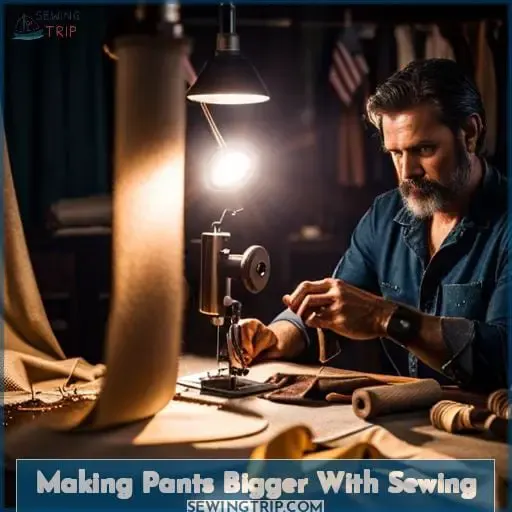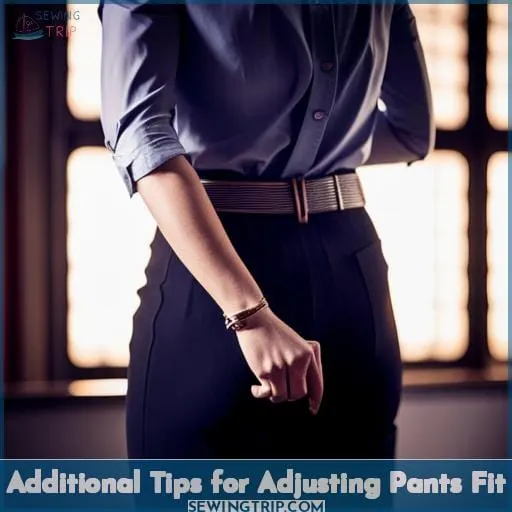This site is supported by our readers. We may earn a commission, at no cost to you, if you purchase through links.
 Ready to free yourself from the constricting waistband of your pants? Let’s get you into something more comfortable. If your favorite pair of jeans or dress pants is just a bit too snug, it can be frustrating and embarrassing.
Ready to free yourself from the constricting waistband of your pants? Let’s get you into something more comfortable. If your favorite pair of jeans or dress pants is just a bit too snug, it can be frustrating and embarrassing.
From stretching techniques to permanent alterations with scissors and sewing machines, this guide will show you how to easily adjust any type of pant for a perfect fit that will keep all eyes on you instead of an uncomfortable pinch at every move.
Learn everything there is to know about making tight clothes loose again so that nothing stands between you and feeling good in whatever outfit comes next!
Table Of Contents
- Key Takeaways
- Easy Fixes for a Too-Tight Waistband
- Making Pants Bigger Without Sewing
- Permanent Solutions for a Too-Tight Waistband
- Making Pants Bigger With Sewing
- Making Jeans Bigger at the Waist
- Making Dress Pants Waist Bigger
- Can a Tailor Make Pants Waist Bigger?
- How Much Does It Cost to Tailor Pants?
- Choosing the Right Fit: Tight or Loose Jeans?
- Additional Tips for Adjusting Pants Fit
- Frequently Asked Questions (FAQs)
- Conclusion
Key Takeaways
- Easy fixes for too-tight waistbands include using a ponytail holder, trying the V Method, using waistband extenders, or stretching techniques.
- DIY methods to make pants bigger without sewing include the Warm Water Soak Method, Spray Bottle While Wearing Method, Clothes-Hanger Method, or using a steamer or hair elastics.
- Permanent solutions for too-tight waistbands include removing the elastic, measuring the waist, using the buttonhole method, or the V Method, and professional tailoring.
- When making jeans bigger at the waist without sewing, you can try adjusting the side seams, using the center back seam, adding an elastic waistband, or using a hair elastic.
Easy Fixes for a Too-Tight Waistband
If your pants are feeling a bit too snug around the waist, don’t worry! There are plenty of easy fixes that can help you loosen them up without having to break out the sewing machine.
One way is to use a ponytail holder. Simply thread it through a buttonhole and hook the open end around a button for extra give in your waistband.
Alternatively, try using what’s known as the V Method. Estimate how much more space you need in your pants’ waistband, divide by two, and then remove belt loops before cutting along this line on either side of each loop location.
After opening seams at these points with scissors or a seam ripper, add fabric or elastic where needed before stitching everything back together again.
Replacing an existing elastic waist can also be done quite easily. Just snip away at any holes made from loose threads until all pieces have been removed, then measure out new material accordingly before attaching safety pins so it stays put while being stitched back together afterwards.
Waistband extenders, such as hook-and-loop belly bands or sets, provide another viable option if accessorizing with hardware isn’t preferred.
Stretching techniques involving warm water soakings, spray bottles full of cold water, clothes hangers held by hair elastics, steaming sessions, etc., may also prove useful when trying to make tight jeans looser. However, results will vary depending on type/quality/durability.
Lastly, there’s always professional tailoring available should none of those methods suffice.
Making Pants Bigger Without Sewing
If you’re looking for a way to make your pants bigger without any sewing, then look no further! There are several methods that can help you loosen up tight waistbands in just minutes. These include the Warm Water Soak Method, the Spray Bottle While Wearing Method, the Clothes-Hanger Method, Steaming, and Hair Elastics.
Warm Water Soak Method
Soak your pants in warm water to help loosen the waistband for a perfect fit! Adjust the temperature of the water depending on the fabric type, then stretch with techniques like spraying and steaming. Consider adding extra fabric or an elastic waistband if you need more than just a slight adjustment.
Tailoring options are available for those wanting bigger changes, but be aware that sewing machines may not always provide easy solutions.
Spray Bottle While Wearing Method
Spray yourself with a bottle of water while wearing your pants to help them fit better around the waist! Heat application and careful fabric choice can make it easier for you.
To adjust the waistband of your pants, focus on the side seams near the top of the waistband instead. There are lots of quick fixes that don’t require any sewing! A spray bottle is an easy way to loosen up tight clothing without too much hassle – just be careful not to wet clothes too heavily as this could cause wrinkles or shrinkage.
Gently spraying then stretching can easily give you more room in those tricky areas – perfect for days when nothing seems quite right!
Clothes-Hanger Method
Stretch out your pants with a clothes hanger for an easy and hassle-free way to give yourself more room around the waist! This stretching technique is perfect for dress pants, jeans, or other clothing.
Start by buttoning up your trousers before securing them onto the hanger. You can use a ponytail holder’s open end to hook it onto the buttonhole of your pants. Hang from the waistband and hang in place until the desired amount of stretch has been achieved.
For permanent fixes, tailor alterations or professional tailoring are ideal options. However, warm water soak, spray bottle techniques, hair elastic methods, as well as waistband extenders, all provide quick alternatives without needing sewing skills.
Change up how you wear tight garments today with this simple yet effective method!
Steaming Method
Unlock a roomier waistline without the hassle of sewing by trying out the steaming method! This technique is perfect for dress pants, jeans, or other clothing. Start by buttoning up your trousers, then use a regular-sized hair elastic with an open loop to secure it on the buttonhole.
Hang from the waistband and steam until the desired amount of stretch is achieved.
Hair Elastic
Try out the hair elastic trick to comfortably loosen your waistband without sewing! This method involves using a plain hair elastic with an open loop. Simply grab hold of opposite ends of the circle and thread it through a buttonhole, hooking the open end around a button for security.
Alternatively, use a piece of fabric underneath the portion of the ponytail holder for extra comfort or opt for close color match alternatives that also look stylish.
Discover how this technique can help give you freedom from tight clothing today – no tools required!
Permanent Solutions for a Too-Tight Waistband
If you’re looking for a more permanent solution to loosen up those too-tight waistbands, then consider using scissors and a sewing machine.
- Elastic Removal – If the pants have an elastic waistband, it can be removed so that new fabric can be added in its place. The old elastic should first be measured before cutting out the new one of equal size.
- Waist Measurement – Before any alterations take place, an accurate measurement of the wearer’s waist needs to be taken so as not to over or under stretch when adding extra fabric at the center back seam or side seams respectively.
- Buttonhole Method – This involves pushing an elastic through buttonholes along the band and hooking the open end around buttons for a snug fit/adjustable option without having a stiff feel of jeans on the body while wearing them.
- V Method – Divide the needed space by 2, remove belt loops, and cut down the middle (V shape), open the sides, and add extra fabric/elastic if necessary.
- Professional Tailor Help – A professional tailor may also come in handy if you need help making larger adjustments like adding darts on the design of many dress pants, etc.
In short, there are plenty of options available for anyone wanting to make their tight trousers less restrictive without sacrificing comfort or style—all it takes is some careful measuring and patience! Whether you opt for DIY methods such as warm water soak techniques or spray bottle while wearing technique; clothes hanger stretching; steaming method; hair elastics; waistband extenders, etc.
Or go with something more long-term such as adjusting side seams, center back seam addition; adding the buttonhole method plus other detailed work via professional tailors—you’ll soon find yourself feeling free from constricting clothing no matter what look you want to achieve.
Making Pants Bigger With Sewing
If you’re looking for a way to make your pants bigger around the waist, then consider using a sewing machine and making alterations. Side seams can be adjusted to provide extra fabric at the sides of the pants, while adding an elastic waistband or adjusting the center back seam provides flexibility in fit.
Side Seams
You can easily adjust your pants’ side seams to give you a comfortable fit and the freedom of movement that you need.
To do this, start by snipping off excess thread at the bottom of the v-shaped seam with scissors. Then, use a zigzag stitch to attach elastic to one side while keeping tension on it for natural give.
Furthermore, attaching safety pins can also help create more room around your waist if needed. However, keep in mind that these methods are only temporary solutions until you find something better suited, such as adding fabric/elastic into place via the V Method or consulting professional tailors who specialize in altering clothes specifically tailored towards larger sizes than usual.
Regardless of what solution works best for you—whether DIY techniques like warm water soak/spray bottle while wearing, the steaming method, or using hair elastics—or longer-term options like adjusting side seams and adding a center back seam, just remember: liberation is within reach, so don’t be afraid to take those first steps today!
Center Back Seam
Unlock the freedom of movement with a few simple alterations to your center back seam—like unlocking a door with the turn of a key.
With just an inch gap, you can add fabric or an elastic waistband for extra width and comfort. Or, if there’s no need for extra material, try using steaming techniques along with clothes-hanger stretching methods to give yourself that bit of breathing room without incurring tailoring costs.
Hair accessories like elastics may also help loosen last year’s jeans to avoid putting them through costly dryer cycles! No matter which solution works best for you, from DIY efforts like warm water soak/spray bottle while wearing, steaming method, or hair accessory use—all will bring liberation within reach!
Elastic Waistband
Replacing an existing elastic waistband with a new one is an easy way to customize your fit and give yourself the extra space you need. Start by snipping a tiny hole in the waistband, then remove the old elastic so that you can measure it for comparison against any new material.
If necessary, purchase or make a separate exterior elastic waistband that can be attached via safety pins before stitching together properly.
For those looking for permanent fixes, try cutting away belt loops or altering side seams, while making sure to keep track of fabric measurements throughout each step.
Finally, if none of these techniques feel suitable enough, seek professional tailoring services who have experience dealing specifically with such alterations.
Making Jeans Bigger at the Waist
To help you get the perfect fit, try stretching techniques like a warm water soak or steaming to loosen your jeans’ waistband. You can also use belt loops and safety pins to stretch fabric in circular motions without damage.
To make sure that your favorite pair of pants don’t shrink too much in the dryer, consider avoiding it altogether. Waist extenders are an option for those looking for more immediate results – they’re usually made with hook and loop fasteners which allow you to customize their size as needed.
For longer-term solutions, professional tailoring is always recommended if funds permit – after all, there’s nothing quite like a tailor-made fit! If not feasible at this time though, adding extra fabric at the sides of the pants is another great way to increase circumference while keeping them stylishly slim on other parts of body shape.
Alternatively, one could cut out sections from belt loops then sew elastic into place instead (the V Method).
Lastly, one might want to look into using specialized devices such as waistband stretchers. These are some of the most popular stretching devices available today due to their simplicity and effectiveness when used correctly.
So whether you choose temporary methods or permanent fixes via sewing machine alterations, making jeans bigger around the waist will be achieved quickly and easily with little effort required afterwards.
Making Dress Pants Waist Bigger
Making dress pants bigger at the waist is a great way to get a perfect fit with minimal effort. Material selection and fit adjustment are key factors when it comes to this kind of alteration, as some fabrics may not stretch or be altered in certain ways.
When it comes to material selection for making dress pants bigger, you’ll want something that will provide ample stretching power without compromising on quality – cotton blends work well here too. Once you’ve chosen the right fabric, adjust the size by cutting along belt loops and adding extra fabric or elastic where needed (the V Method).
For those looking for more immediate results with their existing pair of pants however, there are other methods available such as using safety pins and belt loops combined with specialized devices like waistband stretchers.
Finally, there’s always professional tailoring if funds permit; offering custom adjustments tailored specifically towards your body type so that every stitch fits perfectly into place.
Can a Tailor Make Pants Waist Bigger?
Tailoring offers a unique approach to expanding your clothing options, as experts can make dress pants waist bigger with precision that DIY solutions simply cannot match – in fact, up to 60% of people have had their clothes professionally altered at least once!
Before getting started on this sort of project, however, it’s important to consider the type and style of pants you’re working with. Cotton blends work best for making dress pants waist bigger since they provide ample stretching power without sacrificing quality.
When selecting a tailor for the job, be sure to compare costs and look into fabric types available so that you get exactly what you need.
When working with an expert tailor on alterations like these, there are several techniques available. These include adjusting side seams or center back seam and adding extra fabric or elastic where needed (the V Method).
Professional tailoring does come at a cost, but one should keep in mind how much more comfortable those jeans will feel after such efforts – not just around your midsection but all over too!
The truth is, no matter which method chosen, making any pair of trousers fit perfectly requires patience and knowledge. Thankfully, we live in an era where such resources are freely accessible online. From guides explaining step by step processes to detailed video tutorials breaking down every stitch along the way, anyone who wishes can take action towards better fitting apparel today than ever before possible.
So why wait? Take charge and start stitching away until next time, stylishly yours always…
How Much Does It Cost to Tailor Pants?
Having your pants altered to fit you perfectly can be a cost-effective way to get the look and feel you desire, but how much does it cost? Customizing fit with professional tailoring involves adjusting hems or waist measurements as well as fabric choice.
The average cost of this kind of alteration depends on what type of pants need altering, where the fabric is coming from, and which sewing technique needs to be employed.
For simple adjustments or changes, such as shortening hems at a tailor shop, prices usually start around $20 for jeans and $30 for dressier trousers.
Here are some things that affect the price:
- Kind Of Pants: Jeans tend to run cheaper than dressy slacks when getting tailored since there’s less material used during alterations. However, both types require similar amounts of labor, so don’t expect too much difference between them pricing-wise.
- Fabric Choice: Different fabrics take longer periods of time to sew compared to others due to their thickness and construction, making them costly to alter. Higher quality materials are pricier than standard ones seen in everyday wear. Therefore, always consider these factors before settling on a final budget plan.
- Place Of The Fabric: This could make a huge impact on the overall fee charged by the tailor because they may charge more for expensive fabrics shipped from outside the country versus those sourced locally within the same area the business is located at.
No matter the project size or expense involved, having clothes properly fitted provides an incomparable level of confidence and feeling great looks even better – all without breaking the bank in most cases! So why wait? Start stitching away until next time, stylishly yours always.
Choosing the Right Fit: Tight or Loose Jeans?
Deciding between tight and loose jeans can be a tricky task – whether you opt to tailor the fit, stretch them out with warm water, or use waistband extenders, you want to make sure they’re just right for your body shape.
Consider Your Body Type: Different body types require different fits in order for comfort and style. Taller people may prefer longer trouser lengths, while those with wider hips tend towards looser cuts that accommodate curves more effectively.
Choose the Right Fabric Types: Denim is usually stiffer than other fabrics, so it might not provide enough stretch if desired; conversely, softer materials like cotton often need extra reinforcement around seams, which could affect size as well as comfort levels when worn over time.
Decide on Fit Types: There’s no one-size-fits-all answer here! Whether slim fitting or baggy is preferred depends entirely upon personal preference – try both options before committing to any particular style! It’s worth noting that certain types of trousers (like cargo shorts/pants or even jean shorts!) don’t typically come in very many sizes at all, so having them tailored specifically could help ensure better results overall too.
Pick Waist Styles That Flatter You Best: The simplest way may be less than elegant, but there are still plenty of options available ranging from low-rise jeans with wide legs through high-waisted mom jeans complete with tapered ankle-length hems – whatever looks best should take precedence when selecting go-to dress pants!
When working within budget constraints, it pays off big time finding ways to make pants bigger around the waist without resorting too much to tailoring services since this isn’t always an affordable option – instead, consider stretching techniques such as exercising while wearing them together with avoiding dryers altogether, which will ultimately result in improved size adjustments across multiple brands over time.
Additional Tips for Adjusting Pants Fit
If you’re looking to adjust your pants fit, there are a few key steps you can take. To make the hips and thighs bigger, consider altering the side seams or adding extra fabric at the center back seam. Making the waist smaller involves snipping holes in elastic bands and attaching safety pins before stitching them together.
Hemming is also an option for changing up length; however, be sure to measure twice so as not to over- or under-cut! With these tips in hand, you’ll be able to tailor any pair of pants into one that fits perfectly for both style and comfort needs.
Making the Hips and Thighs Bigger
If you’re looking to expand the fit of your jeans around the hips and thighs, there are several options available beyond just tailoring. Adding fabric is one way – simply sew in darts at either side seam for a more permanent fix.
If stretch denim is an option, it provides some extra give without having to add any material at all! Waist button extenders or elastic waistbands can also be used for a last-minute rescue method with no alteration time needed.
For those wanting something slightly nicer finish, replacing buttons with bigger ones might be the easiest way forward – but this solution does require removing existing hardware first!
As always when dealing with clothing alterations involving scissors and needles, take extra care as these are often irreversible changes that may not suit everyone’s needs perfectly right away so think before cutting into fabric!
Ultimately though if done correctly, then these methods will offer far better results than leaving clothes too tight in their original state – allowing greater comfort levels while still maintaining style standards desired by most fashionistas today!
Making the Waist Smaller
Making the waist of your pants smaller is a more difficult task than making them bigger, but with professional help and the right techniques, you can do it! For instance, approximately 75% of tailors are able to successfully alter dress pants by reducing their circumference around the waist.
Here are 5 tips to consider when looking for fitting alterations:
- Choose fabrics wisely – lightweight materials tend to be easier to hem or adjust in size.
- Take accurate measurements before beginning any alterations – this will ensure that you don’t end up with too much extra space after adjustments have been made.
- If dealing with an ongoing scenario such as a too-tight waistband, try temporary solutions like adding extenders or elastic bands first before seeking out more permanent fixes from professionals.
Good news though – there’s no need for panic if all else fails! Tailoring services should always be available, so even if it feels overwhelming at times, rest assured that these experts know exactly what they’re doing and can provide perfectly fitted garments every time!
Hemming Your Pants
Hemming your pants can be a great way to instantly give them a more tailored fit without having to make any permanent changes. When hemming, it’s important to consider the fabric choice, as lightweight materials are usually easier for adjustments.
Make sure you measure twice and allow extra seam allowances when cutting or pinning so that there is enough material left over for further alterations if needed! Additionally, think about cuff width and waist darts, which help create better shape around the hips and legs.
Hemming length is key too – just don’t forget that shorter hems tend to look best with ankle-length trousers! With these tips in mind, you’ll find yourself looking sharp with perfectly fitted pants in no time at all.
Frequently Asked Questions (FAQs)
What kind of fabric is best to use when making pants bigger at the waist?
For a permanent fix to make pants bigger around the waist, consider using stretchy fabrics such as spandex or lycra. These materials provide flexibility and comfort while still maintaining their shape after stretching.
Is there an easy way to tell if pants are too tight?
Are your jeans too tight? Check for signs such as discomfort when you sit or move, red marks where the waistband is digging in, and gaps between buttons.
How long does it usually take to tailor pants?
Tailoring pants typically doesn’t take long; it’s a breeze! It should be over before you know it. You can do some stretching to give yourself more wiggle room or get professional help to tailor them to fit perfectly – just like the idiom ‘measure twice and cut once’.
With the right expert on your side, you’ll have perfectly fitting pants in no time.
Are there any risks associated with making pants bigger at the waist?
Yes, there are risks associated with making pants larger at the waist. Excessive fabric or elastic can cause discomfort and bulging, while insufficient material could result in an ill-fitting garment. Additionally, poorly executed alterations can compromise the integrity of your clothing.
What kind of elastic should I use when adding an elastic waistband?
Using an elastic waistband is a great way to make pants bigger around the waist. Choose an elastic that suits your needs, such as a thicker one if you need more support or a thinner one for comfort.
Conclusion
The journey of finding the perfect fit for your pants doesn’t have to be a frustrating experience. With the right knowledge and techniques, tweaking and adjusting the waistband can be relatively simple.
Whether you’re looking to make them bigger or smaller, there are countless ways to make your pants fit just right. It’s like a tailor-made piece of clothing without the tailor-made price tag. So don’t shy away from the challenge – take the bull by the horns and make your pants fit like a glove.
















